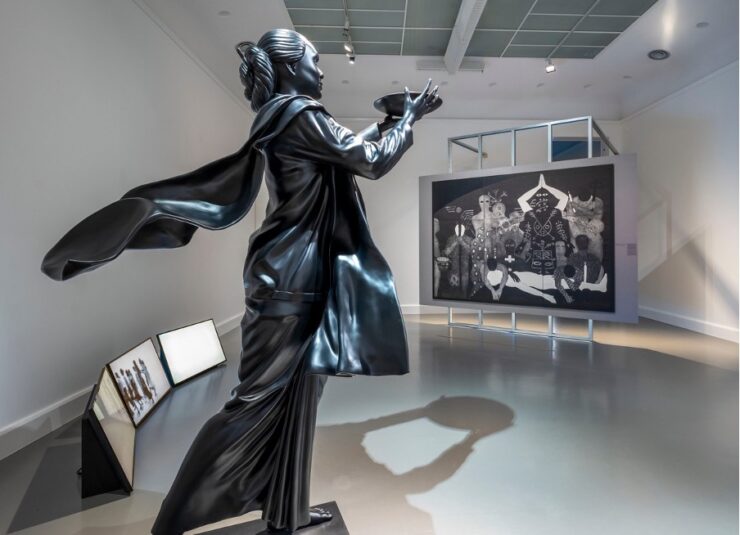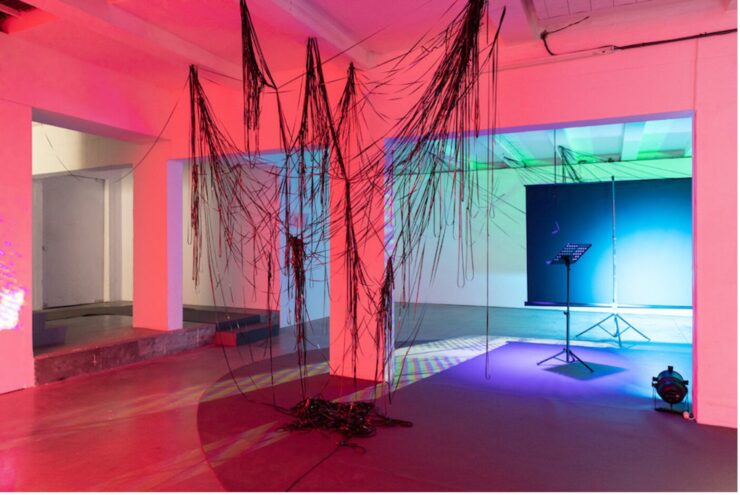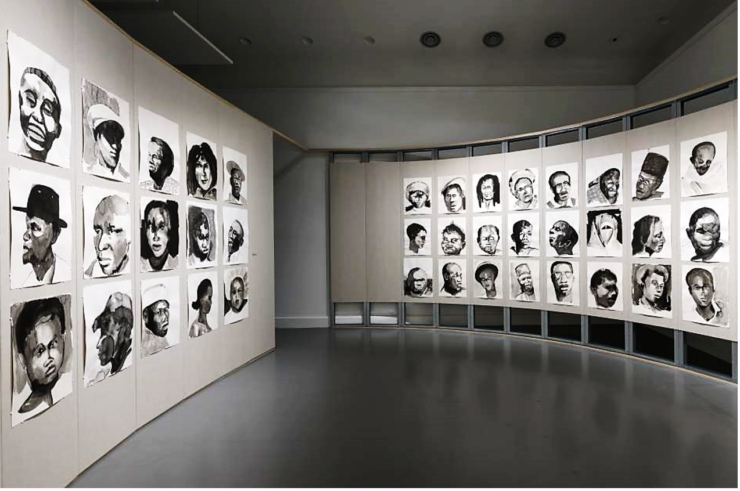News
[Recap] TiM Seminar 2022-23 “Notes on the Political Imaginary and Exhibitions” – Nick Aikens and Ohad Ben Shimon
Good-Bye VHS: The Political Scenography of Imagination
by Olga Efremov

The sixth session of 2022-23 Transmission in Motion seminar series took place at Van Abbemuseum in Eindhoven, current home of the exhibition Rewinding Internationalism. Scenes for the 1990s Today. The session included the introduction and viewing of the exhibition followed by a talk by Nick Aikens, research curator at the Van Abbemuseum, and a PhD candidate at Hdk-Valand, University of Gothenburg and Q and A discussion (Utrecht University 2023). The exhibition which represents a collaboration between a number of artists and curators some of whom were actively involved in shaping 1990s exhibition scene, contains image and sound material from the past and present, archive material and recently made work Lubaina Himid and Magda Stawarska, Didem Pekün and susan pui san lok / lok pui san (Van Abbemuseum n.d.). The types of material used in exhibition included not only archive images, but also various sonic devices as well as visual guides and captions. A number of specific scenographic affordances allowed what Aikens called “making-thinking of the spectators”: intervening in routing the visitors through the exhibition which encouraged seeing the works in different sequences, hanging various structures from the ceiling, and using lighting to reference the notion of spectrality (Figure 1).
When speaking on the conceptual and curatorial intent behind the exhibition, Nick Aikens highlighted three “jump-off” points. First, the idea of “rewinding” as represented by the materiality of VHS tape. In the process of rewinding the tapes, Aikens explains, the images are seen out of sequence, without before and after; the logic of fictional technology acts in a generative way to create new narratives. The second point is the concept of “internationalism”: a rather loose term that contains an assembly of ideas and associations which mean different things to different people. Aikens spoke of the attempt to capture the moments of our present infused with multiple crises, satiated in multiple locations, representing different voices and different contexts. It required a curatorial methodology that allowed exposing the materials in relation to each other. To realise his vision, Aikens had invited a number of colleagues from the museum confederation L’Internationale to form a working group to propose exhibition artefacts from their archives. The third point is “understanding 1990s”, the decade that in Aikens’ opinion represents a fundamental shift in the idea of internationalism. Shifting geopolitics, globalisation, the rise of nationalism: the trends originated in the last decade of the 20th century had shaped the present we are living in now, urging us to think of 1990s as a part of ongoing present.

Figure 1. A fragment of the exhibition: the hanging strands of VHS tape act as a material representation of “rewinding” while the interplay of lights acts as a reference to spectrality.
Aikens noted that the title for the seminar, “Notes on the Political Margin” reflects the academic as well as artistic nature of the exhibition which forms a part of his PhD thesis, situating this project in relation to the curatorial. According to Aikens, the motivation behind the exposition was to explore internationalism as political imaginary through exhibition making as a tool and a mechanism of the formation of curatorial discourse while contributing to understanding curatorial discourse as political engagement that goes beyond exhibition making (Figure 2). Referencing Sarah Pierce’s works on curatorial discourse, Aikens commented on how curatorial as a political engagement often reinforces cultural studies image of Marxist thoughts with particular political claims and specific focus on epistemological. In his opinion, the exhibition works in two registers: as field of operations and as interfacing. At the moment there is still little language to talk and about interfacing; the kind of language we use situated in discourse on political imaginary, the term that has been circulating in the art system as a way of drawing attention to the fuzziness of comparing political with imagination and looking at political using imaginative tools. Political imaginary, commonly understood via European/Anglo anthropology as it appeared in the works of Claudia Strauss and Cornelius Castoriadis, draws on sociology/anthropology to conceptualise imaginary as something not solely constructed, but rather a space of possibility.

Figure 2. A fragment of the exhibition: political imaginary as curatorial discourse
Modern social imaginary, as Aikens suggests, is something deeper than social skins, not separate from society but that which has capacity to institute. In arts the term imaginary is used in different variations, e.g., Exhibitionary Arts of Political Imagination (2022) published as a collaboration between journals Vector and PARSE calls for renewal of political imaginary as a heuristic device reflecting the propositional nature of imagination and exhibition making at the times of radical polarisation. Political imaginary in relation to the acts of performative imagination is seen by Aikens as an interplay between the ideas and physical exhibition that he expresses through the metaphor of “loose scaffolding”, noting that through the process of making an exhibition he “came to understand that wobbliness”. The process of assembly of the people and materials allows the exploration of the subject through the process of “figuring things out”.
According to Aikens, what we want today from the term “political imaginary” is a particular location of art system as well as the understanding of how it relates to internationalism, what it makes to wake the history in this place both in method and in content or form which brings together different stories, references and timelines. Specifically located bodies that mutually reinforce one another allow moving between contexts, places and ideologies as a kind of speculative time travel. This back/forth is not binary, but rather an abstraction toward speculative object forms. It is a kind of interfacing that allows to think through the political imaginary and as such it draws heavily on scenography. Aikens worked with a theatre scenographer whom he credits with the decision to have things hanging in space as an expression of their relation to one another and of their spectrality as the spectators have to move through them. These different forms of interfacing are referential and non-consequential yet instrumental in understanding political imaginary through exhibition format where the visitors can see how they echo one another. Through remix of the art system, internationalism is not represented or defined but comes into view as one is moving across speculatively and associatively through that space of possibilities. A special sonic / visual bleed unique to exhibition reflects solidarity and allegiance of the institutions that are part of museum confederation transnational alliances. In this momentary fleeting space where political imaginary comes to work “international” can be perceived but never comprehended.
References
Utrecht University. 2023. “‘Notes on the Political Imaginary and Exhibitions’ – Nick Aikens and Ohad Ben Shimon.” Transmission in Motion. February 15, 2023. https://transmissioninmotion.sites.uu.nl/notes-on-the-political-imaginary-and-exhibitions-ohad-ben-shimon-and-nick-aikens.
Van Abbemuseum. n.d. “Rewinding Internationalism.” Vanabbemuseum.nl. Accessed April 26, 2023. https://vanabbemuseum.nl/nl/zien-en-doen/tentoonstellingen-activiteiten/rewinding-internationalism.

